Method Area 1
In the recent decade exciting new applications of topological and geometric methods have been discovered. Such methods are in particular used to analyze and find structure in data sets. Computational and applied topology became very active research areas. In the MB 1 and RTG 2229 these developments played a role both in the doctoral education as well as in research. We highlight some examples.

The RTG 2229 and the excellence cluster STRUCTURES in Heidelberg organized a workshop on "Geometry, Topology and Computation" (June 12-14, 2019) that brought applied scientists and mathematicians together to explore applications of topology and geometry in biology, data science and engineering. The RTG 2229 cooperated with the TRR 191 in the organization of a summer school on "Persistent homology and Barcodes" (August 5-9, 2019) whose aim was to explore the flow of ideas from applied topics back to theoretical mathematics, specifically in symplectic topology. In the winter term 2020/21 and summer term 2021 Andreas Ott offers a two-semester course on persistent homology and applied topology which is open for all MathSEE members.
More Information
Petra Schwer (formerly IAG) won the KIT YIN Award 2019 for her joint project ''The geometry of Big-Data Clouds'' with climate scientist Aiko Voigt in which they analyze cloud structures in climate models through cubulation methods in geometric group theory.
More Information
In a current project, Andreas Ott is uses persistent topology to explore critical mutations in the evolution of viruses
More Information
Property T, a notion from geometric group theory, proved to have intriguing consequences in mathematics and computer science (resilient networks using expanders and group-theoretic hash functions). Property T and its computer-assisted verification will be the subject of study of a DFG project (project number 441426599) between Roman Sauer and Marek Kaluba.
More Information